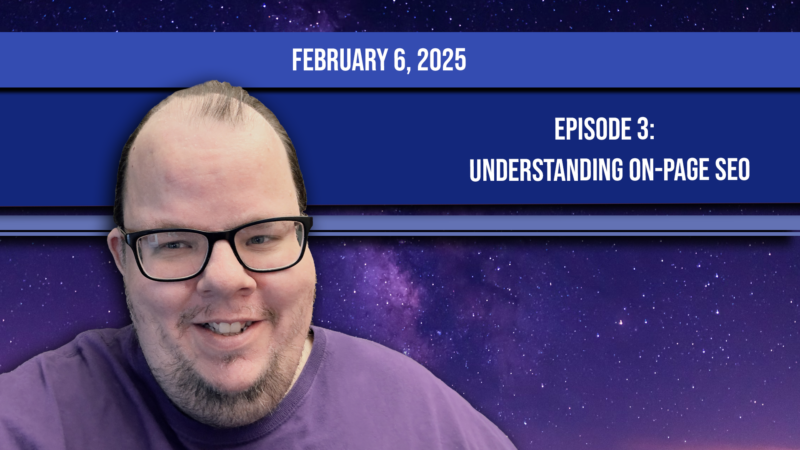Watch the Podcast!
Understanding On-page SEO
On-page SEO is the process of optimizing individual web pages to rank higher in search engine results and attract more relevant traffic. It involves refining various elements of a webpage, including content, HTML source code, and site structure, to make it more appealing to search engines and users alike. Unlike off-page SEO, which focuses on external factors like backlinks and social signals, on-page SEO is entirely within the webmaster’s control.
Keyword Optimization
Keywords play a crucial role in on-page SEO. Proper keyword research helps identify the terms users are searching for, allowing content creators to strategically place these keywords within the page. Keywords should appear in the title tag, meta description, headings, and throughout the content naturally. However, excessive keyword stuffing can lead to penalties from search engines, so maintaining a balanced and organic approach is essential.
Title Tags and Meta Descriptions
Title tags and meta descriptions are vital for both SEO and user engagement. The title tag, which appears in search engine results, should be concise, descriptive, and include primary keywords. Ideally, page titles need to be compelling, with the most important information showing up in the first 60 characters. But, they don’t have to be a certain length. In fact, some SEOs swear by using 200 character page titles. Meta descriptions, while not a direct ranking factor, influence click-through rates. A compelling and informative meta description can entice users to click on the page, increasing traffic and engagement.
URL Structure
A well-structured URL is crucial for on-page SEO. URLs should be short, descriptive, and contain relevant keywords. Avoid using long, complicated URLs with unnecessary parameters or numbers. Search engines and users prefer clean URLs that provide insight into the content of the page. For example, a URL like example.com/best-seo-practices is more effective than example.com/index.php?id=12345.
Header Tags (H1, H2, H3, etc.)
Header tags help structure content and improve readability. The H1 tag should contain the main keyword and describe the page’s primary topic. Subheadings (H2, H3, etc.) should be used to break content into logical sections, making it easier for readers and search engines to understand. Well-structured content improves user experience and can contribute to better search rankings.
Content Quality and Optimization
High-quality content is the backbone of on-page SEO. Search engines prioritize valuable, informative, and original content. Pages should provide in-depth information that answers user queries comprehensively. Incorporating related keywords, internal links, and multimedia elements like images and videos can enhance content value. Additionally, keeping content up to date and regularly refreshing older pages can help maintain rankings.
Internal Linking
Internal links connect different pages within a website, helping both users and search engines navigate the site efficiently. Strategic internal linking distributes link equity and keeps users engaged by directing them to relevant content. Anchor text should be descriptive and include keywords where appropriate, enhancing the page’s relevance for search queries.
Image Optimization
Images enhance user experience, but they must be optimized for search engines. Descriptive file names and alt text help search engines understand image content. Compressing images reduces file size, improving page load speed without sacrificing quality. Faster-loading pages contribute to better rankings and user experience.
Mobile-Friendliness
With the increasing use of mobile devices, having a mobile-friendly website is critical. Google prioritizes mobile-first indexing, meaning it primarily considers the mobile version of a website for ranking. A responsive design, easy navigation, and fast-loading pages ensure a seamless experience across devices, improving search performance.
Page Speed Optimization
Page speed is a ranking factor that affects both user experience and SEO. Slow-loading pages lead to higher bounce rates and lower engagement. Optimizing images, leveraging browser caching, minimizing unnecessary scripts, and using a content delivery network (CDN) can improve loading times. Google’s PageSpeed Insights tool can help identify areas for improvement.
Schema Markup
Schema markup is a form of structured data that helps search engines understand the context of content. It enhances search results with rich snippets, including star ratings, event details, and FAQs, making listings more attractive and increasing click-through rates. Implementing schema markup can provide a competitive edge in search rankings.
Mastering on-page SEO requires attention to detail and consistent optimization. By focusing on keyword placement, title tags, meta descriptions, URL structure, content quality, internal linking, image optimization, mobile-friendliness, page speed, and schema markup, websites can achieve higher rankings and better user engagement. Regularly analyzing and refining on-page SEO strategies ensures long-term success in an ever-evolving search landscape.
Is this all too much for you? Would you rather have a full-time, salaried, full benefits SEO analyst doing your SEO for you? Hire Brian Harnish today! You will be glad you did.

